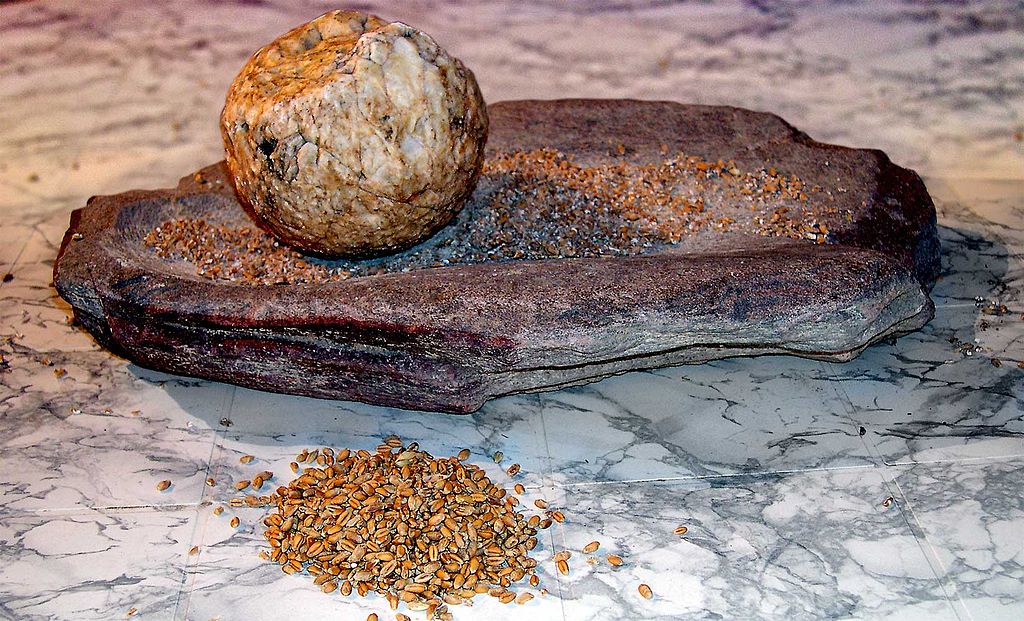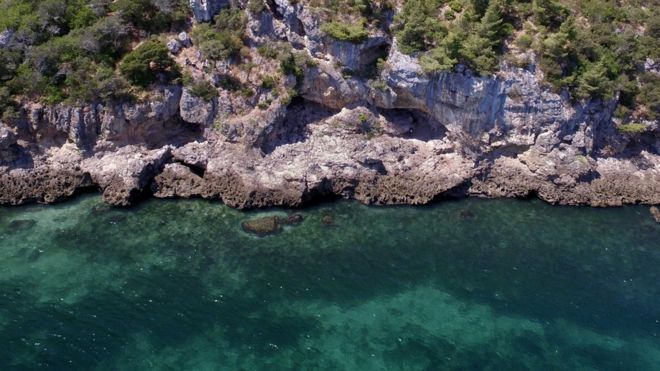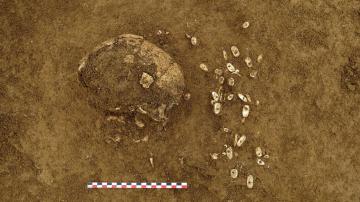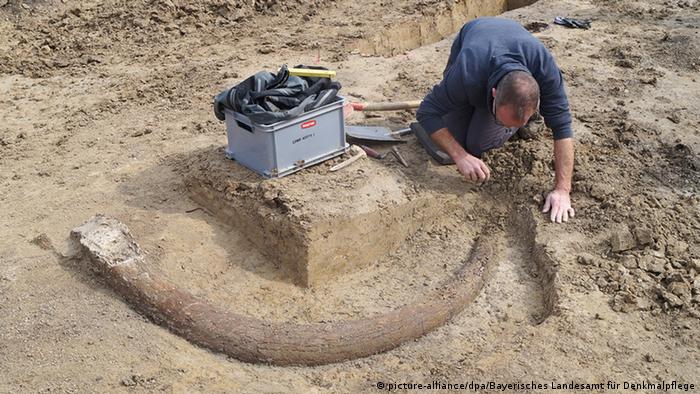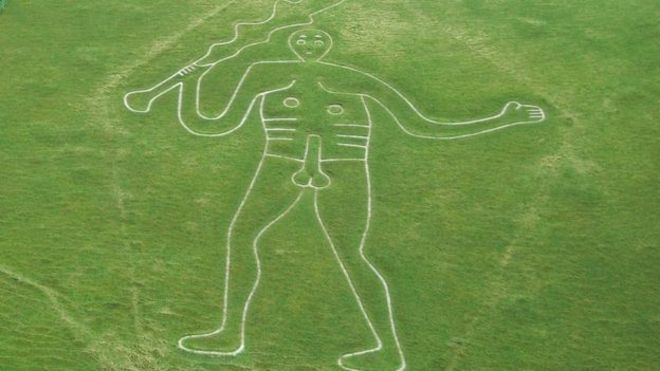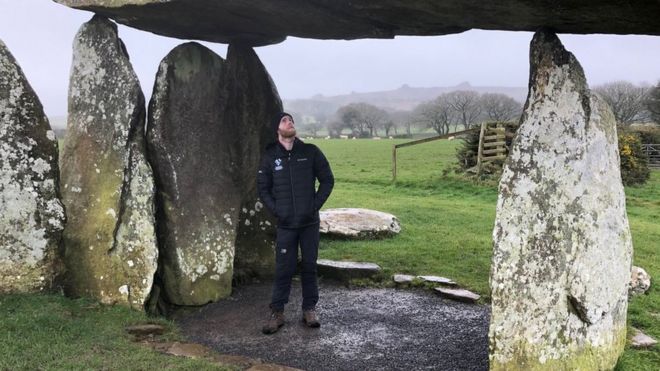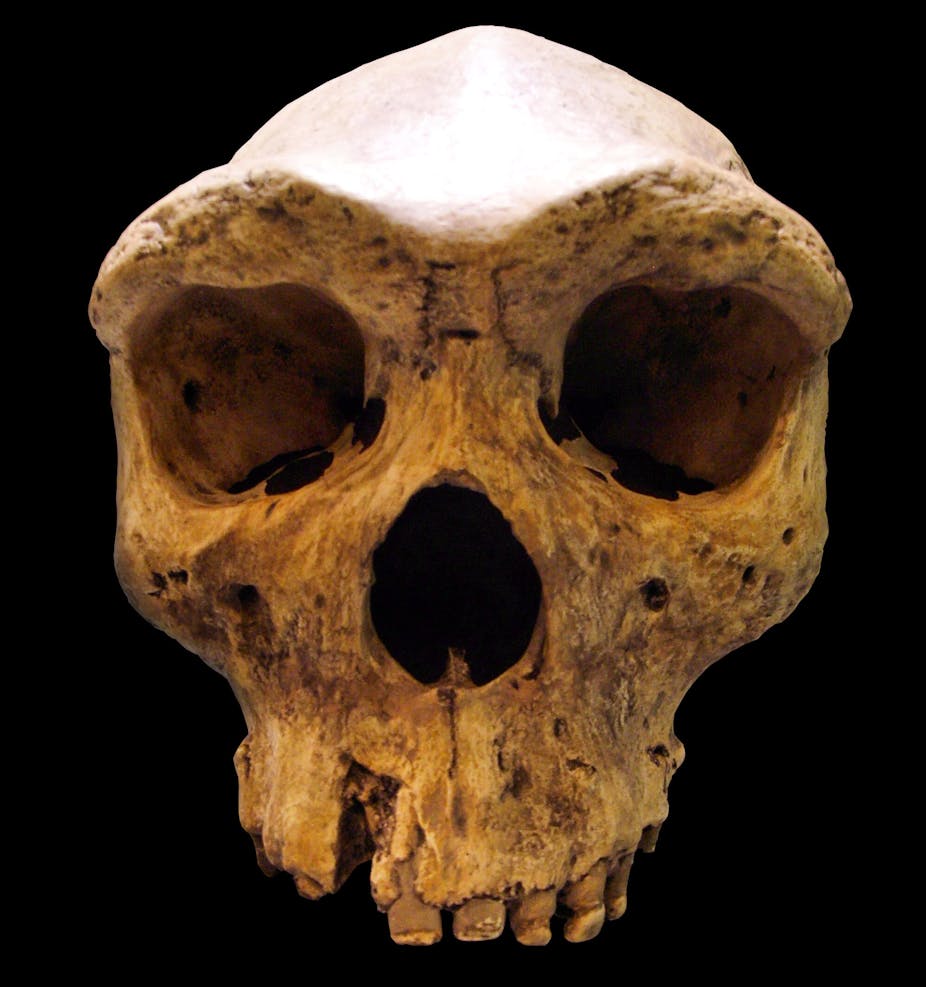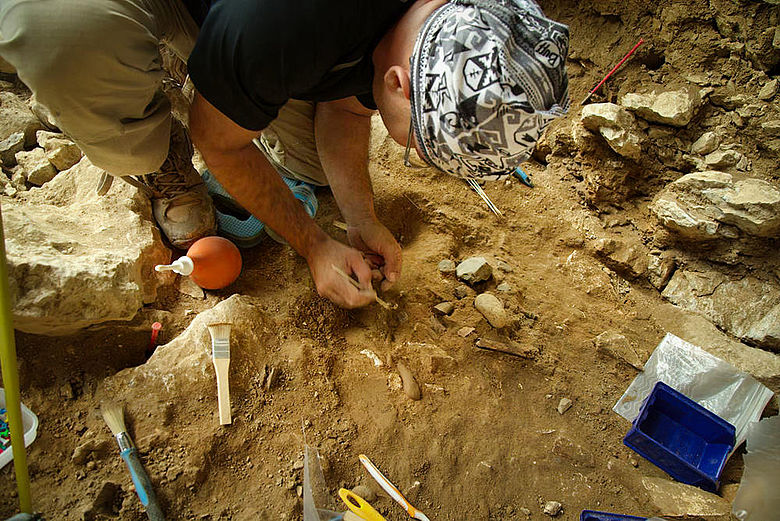The Prehistoric Archaeology Blog is concerned with news reports featuring Prehistoric period archaeology. If you wish to see news reports for general European archaeology, please go to The Archaeology of Europe Weblog.
Tuesday, March 31, 2020
Virtual Visits to Sites and Museums
Self-isolating and bored?
You can find a list of Virtual Visits to Sites and Museums at:
http://emas-archaeology.org/useful-websites/virtual-visits-to-sites-and-museums/
to help you pass the time.
Monday, March 30, 2020
Two of Europe’s Biggest Cairns are About to Be Buried in Trash
Two of the biggest European cairns are facing destruction in the World Heritage city of Maulbronn, Germany. If it happens, the prehistoric monuments would be lost and scientific investigation impossible. This would be extremely unfortunate for all the citizens who would like to see these huge prehistoric cairns restored – not buried under trash.
If the present owners of the city’s quarry - Lauster-Steinbruch Stuttgarter Straße - had their way, the mighty buildings would be sold to the landfill operator Fischer in Weilheim and be covered by 400,000 cubic meters of construction waste.
The Massive Cairns of Maulbronn
In the archaeology of Western Europe these impressive relics are generally referred to as megalithic cairns , but they are totally undervalued in Maulbronn. In other parts of Europe, these monuments have been investigated and restored for almost 70 years.
Read the rest of this article...
Saturday, March 28, 2020
How Stone Age humans unlocked the glucose in plants
Ground stones were a 'major evolutionary success' as they allowed people to unlock the energy in plants by making flour.
Image credit - José-Manuel Benito Álvarez/Wikimedia commons
Plants rich in starch helped early humans to thrive even at the height of the last Ice Age, researchers say.
While the evidence around meat eating is clear, the role of plant foods is less understood. Animal bones can last millions of years and still show cuts made by human butchering tools, whereas almost all plant remains disintegrate.
But new studies into the remains of plants that do exist are uncovering why and how our ancestors ate them.
Read the rest of this article...
Neanderthals ate sharks and dolphins
There is evidence of the intensive and long-term exploitation of marine food resources at Figueira Brava JOAO ZILHÃO
Neanderthals were eating fish, mussels and seals at a site in present-day Portugal, according to a new study.
The research adds to mounting evidence that our evolutionary relatives may have relied on the sea for food just as much as ancient modern humans.
For decades, the ability to gather food from the sea and from rivers was seen as something unique to our own species.
Scientists found evidence for an intensive reliance on seafood at a Neanderthal site in southern Portugal.
Neanderthals living between 106,000 and 86,000 years ago at the cave of Figueira Brava near Setubal were eating mussels, crab, fish - including sharks, eels and sea bream - seabirds, dolphins and seals.
Read the rest of this article...
HABITATS ET SÉPULTURES DU NÉOLITHIQUE AU HALLSTATT À BRÉVIANDES (AUBE)
À Bréviandes (Aube), une fouille de l’Inrap a livré des habitats et des sépultures du Néolithique ancien jusqu’au Néolithique récent. La Protohistoire est également représentée sur le site avec une trace d’occupation au Bronze ancien, une nécropole du Bronze final et une fosse de combustion du Hallstatt ancien à début moyen.
Read the rest of this article...
Cave find shows Neanderthals collected seafood, scientists say
A reconstruction of a Neanderthal created for the Natural History Museum in London.
Photograph: Richard Gray/Alamy
Until now, many Neanderthal sites had shown only small-scale use of marine resources; for example, scattered shells. But now archaeologists have excavated a cave on the coast of Portugal and discovered a huge, structured deposit of remains, including from mussels and limpets, dating to between 106,000 and 86,000 years ago.
Researchers say the discovery shows that Neanderthals systematically collected seafood: in some layers the density of shells was as high as 370kg per cubic metre. They say this is exciting because the use of marine resources on such a scale and in such a way had previously been thought to be a trait of anatomically modern humans.
Read the rest of this article...
German archaeologists unearth massive mammoth tusk
Bavarian authorities announced Friday evening that archeologists had found an unusually large, ice-age mammoth tusk during an excavation .
The tusk, measuring nearly 2.5 meters (8 ft) in length, was found southeast of the city of Regensburg as archeologists were looking for remains of a 15th-century town, Bavaria's Regional Office for Cultural and Historic Preservation said in a press release.
"With its 2.45-meter length, including tip tooth, this tusk is an extraordinarily complete find. An absolute stroke of luck," said Gertrud Rössner, the head of the state's geological and paleontological mammal collection.
Read more: Stone-Age 'chewing gum' reveals human DNA
Mammoths lived in Bavaria, Germany's most southwest state, until 20,000 years ago. In it is not usually for mammoth remains to be unearthed in Bavaria but finding such a long and complete tusk is extremely rare, the office said.
Read the rest of this article...
Thursday, March 26, 2020
Tests to determine age of Cerne Abbas Giant
Cerne Abbas Giant
Archaeologists are hoping to establish the age of an ancient naked figure sculpted into a chalk hillside.
Soil samples have been extracted from the Cerne Abbas Giant in Dorset. Tests are expected to reveal a "date range" for when the landmark was created.
It is hoped results, on soil samples from the giant's elbows and feet, will be available in July.
The technique used will be the same as that used to date the Uffington White Horse in Oxfordshire in the 1990s.
Prof Phillip Toms, of the University of Gloucestershire, will attempt to date the samples using a technique called optically stimulated luminescence (OSL).
Read the rest of this article...
Saturday, March 21, 2020
Trnava archaeologists made a 6,000-year-old discovery Čítajte viac: https://spectator.sme.sk/c/22359494/trnava-archaeologists-made-a-6000-year-old-discovery.html
Ceramic fragments found under the fortification wall prove the skilfulness of the Lengyel culture.
Archaeologists discovered in Trnava's Zelený Kríček settlement hole many decorated ceramics fragments, antler tools and fragments of stone tools older than 6,000 years.
The investor is building a polyfunctional object near the gallery and the research, according to its head, Andrej Žitňan, uncovered an object which could be a part of the larger settlement discovered four years ago at Františkánska Street.
The discovery is located outside the middle age centre of the town just in front of the town's fortification wall.
Read the rest of this article...
Fine-tuning radiocarbon dating could 'rewrite' ancient events
A human femur, thought to be from medieval times, being sampled for carbon dating
[Credit: James King-Holmes/Science Photo Library]
Radiocarbon dating, invented in the late 1940s and improved ever since to provide more precise measurements, is the standard method for determining the dates of artifacts in archaeology and other disciplines.
"If it's organic and old - up to 50,000 years - you date it by radiocarbon," said Sturt Manning, the Goldwin Smith Professor of Classical Archaeology in the College of Arts and Sciences.
Manning is lead author of a new paper that points out the need for an important new refinement to the technique. The outcomes of his study, published in Science Advances, have relevance for understanding key dates in Mediterranean history and prehistory, including the tomb of Tutankhamen and a controversial but important volcanic eruption on the Greek island of Santorini.
Radiocarbon dating measures the decomposition of carbon-14, an unstable isotope of carbon created by cosmic radiation and found in all organic matter. Cosmic radiation, however, is not constant at all times. To account for fluctuations of cosmic radiation in the Earth's atmosphere, the radiocarbon content of known-age tree rings was measured backward in time from the 20th century, for thousands of years.
Read the rest of this article...
Thursday, March 19, 2020
Oldest Circular Structure Discovered – and It’s Made of Mammoth Bones
25,000-year-old mammoth bone structure, Kostenki, Russia: 12.5 meters in diameterA.E. Dudin
Mysterious bone circle built 25,000 years ago from the remains of at least 60 mammoths seems to have been too big – and smelly – to be a dwelling, archaeologists posit
While glaciers rolled over Eurasia as the Ice Age reached its peak, prehistoric persons in what is today Eastern Europe eschewed fleeing south, possibly because it didn’t occur to them, and built structures against the desperately cold winds from the material they had at hand: mammoth bones.
Now archaeologists are reporting the discovery of the oldest and biggest of the roughly 70 circular structures made of woolly mammoth bones that’s ever found in Eastern Europe. Measuring over 12.5 meters in diameter and dating to about 25,000 years ago, this third such structure, unearthed in Kostenki, Russia, is so huge that no less than 60 mammoths were used to build it, an international team of archaeologists report in the journal Antiquity on Monday.
“Mammoth bones are very heavy and building the circular structure represents a huge investment of time and energy by the humans that built this,” lead author Dr. Alexander Pryor of the University of Exeter tells Haaretz.
Read the rest of this article...
Wednesday, March 18, 2020
Investigating a pre-Roman oil press
The oil press under excavation
Excavations near Ferrandina in southern Italy, an area rich in sites dating from the Iron Age to the Lucanian period (8th-3rd century BC), have been investigating an ancient olive oil press identified during preventative archaeological work in 2007.
Read the rest of this article...
The tooth enamel of the Atapuerca hominids grew faster than in modern humans
The CENIEH has conducted the first study which tackles counting the two types of enamel growth lines, in Lower Pleistocene and Middle Pleistocene populations in Europe. The data obtained in this research, together with those from other studies under way, could constitute the first solid evidence showing that the hominids from the Sierra de Atapuerca reached maturity earlier than modern humans
The Dental Anthropology Group of the Centro Nacional de Investigación sobre la Evolución Humana (CENIEH) has just published a paper in the journal Scientific Reports, led by the paleoanthropologist Mario Modesto-Mata, which counts for the first time the two types of growth lines observed in the tooth enamel of Lower and Middle Pleistocene hominids in Europe. This investigation has focused in particular on the species recognized at the sites in the Sierra de Atapuerca. The results indicate that the growth rate of the enamel in these hominids could have been up to 25% faster than in Homo sapiens.
This work, in which New York University and University College London as well as other institutions also participated, studies in minute detail the formation of enamel in the Atapuerca hominids, both at the sites of Sima del Elefante (1.2 million years), Gran Dolina-TD6 (Homo antecessor: 850,000 years) and Sima de los Huesos (430,000 years), in addition to in a fairly extensive collection of Homo sapiens teeth.
Read the rest of this article...
Tuesday, March 17, 2020
Mysterious bone circles made of mammoth remains help explain how man survived Ice Age
The majority of the bones found at the site are from mammoths. A total of 51 lower jaws and 64 individual mammoth skulls were used to construct the walls of the 30ft by 30ft structure and scattered across its interior. ( PA )
Around 70 of these structures are known to exist in Ukraine and the west Russian Plains.
The bones at one site are more than 20,000 years old, new analysis suggests, making it the oldest such circular structure built by humans discovered in the region.
Researchers said the bones were most likely sourced from animal graveyards, and the circle was then hidden by sediment and is now one foot below current surface level.
Read the rest of this article...
Mysterious Ice Age structure made from hundreds of mammoth bones discovered in Russia
Around 25,000 years ago, hunter-gatherers used the bones from 60 mammoths to build a large circular structure in Russia.
And no one knows why.
Researchers have excavated the site in an attempt to understand it, but they don't know why the structure was built, according to a new study.
This isn't the first "mammoth house" to be found in Russia, but it is the oldest and largest, measuring 41 feet across.
In the 1960s and '70s, researchers found similar, smaller buildings at the site, which they dubbed Kostenki 11. It's 310 miles south of Moscow and now home to a museum, the State Archaeological Museum-Reserve Kostenki.
Read the rest of this article...
Fife farmer, 80, to face trial accused of carving path through ancient Angus standing stones site
Forfar Sheriff Court
An 80-year-old Fife farmer has denied damaging standing stones in a nationally important Neolithic or Bronze Age Angus site by carving a path through it for tree-clearing works.
Andrew Simpson will face trial later this summer in relation to four charges connected to alleged damage to the registered stone circles at Baldovie Wood, near Kirriemuir.
Prosecutors say he caused damage to two stone circles and three monoliths with mechanical works and then tried to repair it by replacing the stones after being told he should not.
The Cupar farmer has been charged under the 1979 Ancient Monuments and Archaeological Areas Act but was not present at Forfar Sheriff Court when his case called on Thursday and tendered a not guilty plea by letter.
Read the rest of this article...
Monday, March 16, 2020
Historic Welsh sites to be protected by vandalism patrols
Archaeologist Tomos Jones says pieces of Preseli bluestone have been put up for sale online
Plans to tackle heritage crime have been extended to protect historic sites across Wales.
Archaeologists, national park officials and Dyfed-Powys Police officers have held a meeting to discuss growing concerns about vandalism.
At the conference in Llandrindod Wells, Powys, areas at risk of damage were outlined and training was given on how to best protect remote monuments.
Police, Cadw wardens and park rangers will regularly patrol sites.
Read the rest of this article...
Saturday, March 14, 2020
Whale Bone Genetics and the Extraordinary Closure of a Broch
The Cairns and the sea. Looking across Windwick Bay.
Photo: Bobby Friel @Takethehighview
New DNA results shed light on Iron Age use of whale bone and the remarkable process of ending a broch two thousand years ago.
Results of DNA investigations undertaken on a large collection of whale bone from the University of the Highlands and Islands Archaeology Institute Iron Age archaeological site of The Cairns, have afforded a glimpse into the complex relationship of Iron Age communities with whales.
In particular, the identification of multiple whale bones as belonging to a single large fin whale shows how its carcase was strategically and even ceremonially used and deposited during the ending of the monumental broch.
Read the rest of this article...
How AI could help translate the written language of ancient civilizations
The OI began archaeological expeditions to the ancient city of Persepolis in the 1930s, where the uncovered tens of thousands clay tablets containing cuneiform. A collaboration between the OI and the Department of Computer Science using a machine learning program could allow faster translation of these tablets
[Credit: the OI]
Twenty-five centuries ago, the "paperwork" of Persia's Achaemenid Empire was recorded on clay tablets—tens of thousands of which were discovered in 1933 in modern-day Iran by archaeologists from the University of Chicago's Oriental Institute. For decades, researchers painstakingly studied and translated these ancient documents by hand, but this manual deciphering process is very difficult, slow and prone to errors.
Since the 1990s, scientists have recruited computers to help—with limited success, due to the three-dimensional nature of the tablets and the complexity of the cuneiform characters. But a technological breakthrough at the University of Chicago may finally make automated transcription of these tablets—which reveal rich information about Achaemenid history, society and language—possible, freeing up archaeologists for higher-level analysis.
That's the motivation behind DeepScribe, a collaboration between researchers from the OI and UChicago's Department of Computer Science. With a training set of more than 6,000 annotated images from the Persepolis Fortification Archive, the Center for Data and Computing-funded project will build a model that can "read" as-yet-unanalyzed tablets in the collection, and potentially a tool that archaeologists can adapt to other studies of ancient writing.
Read the rest of this article...
Thursday, March 12, 2020
Ancient Art Found in Basque Country Changes Understanding of Prehistoric Society
The crude red outline and interior color wash is typical of pre-Magdalenian Paleolithic art, over 20,000 years oldB. Ochoa / M. García-Diez / I. Vigiola
Spain and France are hot spots of Paleolithic sites and art going back thousands and tens of thousands of years. On the other hand, the enigmatic Basque Country, which straddles the border between those two countries, was considered to be a graphic void. There were plenty of Stone Age sites there, where prehistoric peoples had clearly lived, but art had only been found in a measly six caves.
Thus, the full extent of ancient art in Basque Country just hadn’t been noticed, argue authors Blanca Ochoa of the Universidad del Pais Vasco in Spain, with fellow archaeologists Marcos García-Diez and Irene Vigiola-Toña, in a recent paper in the journal Antiquity, describing in exquisite detail the newly discovered parietal pictures in Danbolinzulo Cave.
Read the rest of this article...
Monday, March 9, 2020
Wild boars provide archaeologists with clues to early domestication
Deformation of the calcaneus (tarsal bone) in wild boars reared in captivity compared to wild boars in their natural environment. The coloured dots indicate the degree of deformation (minimum in dark blue, maximum in red). The deformations are mainly related to an elongation of the muscle insertion area in the highest part of the bone [Credit: Hugo Harbers/AAPSE/CNRS-MNHN]
Using the wild boar as an experimental model, a multidisciplinary team made up of scientists from the CNRS and the French National Museum of Natural History have shown that a life spent in captivity has an identifiable effect on the shape of the calcaneus, a tarsal bone that plays a propulsive role in locomotion.
Being relatively compact, this bone is well preserved in archaeological contexts, which makes it possible to obtain information about the earliest placing of wild animals in captivity.
Thursday, March 5, 2020
Arms and the man
This striking reconstruction depicts a dual-crested helmet that was found in an Iron Age grave at North Bersted, West Sussex. Created for an exhibition centred on the burial – currently running at the Novium Museum in Chichester – it imagines how this unique object, found in pieces, may have looked when complete. [Image: Chichester District Council]
Reconstructing the life and times of an Iron Age warrior
Why was an Iron Age warrior buried in West Sussex 2,000 years ago, equipped with a sword, shield, and spectacular helmet? With a new exhibition in Chichester exploring these finds, Carly Hilts found out more about this unique grave and its enigmatic occupant from Amy Roberts and Portia Tremlett.
Over 2,000 years ago, in what today is West Sussex but at the time lay within the territory of the Iron Age Regni tribe, an elaborate funeral was taking place. The man being laid to rest was an important and seemingly well-respected individual, with his mourners sending him to the grave accompanied by an extraordinary array of warrior regalia – a rare honour in a region where, at this time, cremation was the norm.
Read the rest of this article...
British Museum acquires 3,000-year-old Shropshire sun pendant
The pendant was made by someone who was clearly skilled in their craft around 1,000-800BC. Photograph: British Museum
Gold bulla is described as one of the most important bronze age finds of the last century
The British Museum has acquired a shimmering 3,000-year-old gold sun pendant heralded as one of the most important bronze age finds of the last century.
The astonishingly well-preserved pendant, or bulla, was discovered by a metal detector enthusiast in Shropshire in 2018.
Neil Wilkin, the museum’s bronze age curator, recalled dropping everything when he first saw it. “I was absolutely flabbergasted, I couldn’t believe my eyes,” he said. “To me it is the most important object from this period, the first age of metal, that has come up in about 100 years.”
The pendant has been purchased for £250,000 using money from the Art Fund and the American Friends of the British Museum.
Read the rest of this article...
Wednesday, March 4, 2020
Walberton’s ‘warrior’ burial
Archaeologists from ASE excavating the ‘warrior’ burial.
[Image: Archaeology South East / UCL]
The grave of a late Iron Age or early Roman ‘warrior’, who had been laid to rest with a sword and spear, has been discovered in Walberton, West Sussex.
The burial was found by Archaeology South East (ASE), the commercial branch of UCL’s Institute of Archaeology, during investigations ahead of the construction of a new housing development. The rectangular grave cut, which measured 2.8m by 1.2m, was initially interpreted as a large pit, but lead archaeologist Teresa Viera soon realised that the team had uncovered something much more exciting.
While the local soil conditions meant that no human remains had survived, traces of a wooden ‘container’ (2m by 0.8m) on which the body may have been lowered into the ground could still be seen, as well as an impressive iron sword, an iron spearhead, and four ceramic vessels.
Read the rest of this article...
Stone Age Seafood-Based Diet Was Full Of Toxic Metals
Cod fishes floating in aquarium, Alesund, Norway. Getty
Modern paleo-diets, characterized by avoiding agricultural products and eating things like meat, fish, and naturally occurring seeds and fruits, gained quite some popularity in the last years. But a new study suggests that the original paleo-diet, some 9,500 years ago at the end of the last ice age, was downright toxic.
In 2015, researchers reported that cod caught off the North American coast around 6,500 years ago by Stone Age hunter-gatherers contained more than 20 times the levels of mercury recommended for humans today. To find out whether this problem was more widespread, a team of archaeologists studied the feeding habits of human societies living near the sea. The researchers selected eight archaeological sites from the Norwegian Arctic, spanning 6,300 to 3,800 years in age. They analyzed the chemical composition of bones of animals, like Atlantic cod and harp seals, disposed of in ancient garbage pits, and so preserved to this day. Both species were among the main ingredients in the diet of the local people, even if the early hunter-gatherers, based on cut marks found on the bones, also successfully hunted for haddock, whale, dolphin, reindeer and beaver.
Read the rest of this article...
Underwater study reveals possible quay at Brú na Bóinne
Using popular maps applications from Google and Apple, a journalist found at least 15 unrecorded monuments in the Brú na Bóinne complex. Photograph: Dara MacDónaill
An underwater archaeological reconnaissance of the bed of the River Boyne near the Brú na Bóinne complex in Co Meath has revealed features that may represent log boats or man-made quays, a research conference was told on Saturday.
The sonar study, carried out by Annalisa Christie of University College Dublin and Dr Kieran Westley of University of Ulster, surveyed 10km of the river from Oldbridge to a weir 1.8km east of Slane Bridge.
Christie told the conference, titled The Pleasant Boyne and organised by the UCD school of archaeology as part of its world heritage programme, that it was likely that for the first visitors to this landscape, the river provided the easiest way to travel, offering an accessible route through a largely wooded landscape. As such, it represented a major communications artery, not just for local visitors but also connecting communities in the area to those from farther afield, such as Wales or even Orkney.
Read the rest of this article...
Spain's mysterious underwater 'Stonehenge'
Thought to be more than 4,000 years old, the Dolmen of Guadalperal was “invisible” for almost 60 years – until it unexpectedly reappeared.
Europe suffered an unusually hot summer in 2019. Seven weather stations in Spain recorded their highest temperatures ever in June, and higher-than-average temperatures and drought were registered across the country in July and August. However, the scorching weather conditions revealed an unexpected sight in the Spanish province of Cáceres: as the drought caused the shoreline of the Tagus River to recede, a 4,000- to 7,000-year-old circular monument emerged in the middle of the Valdecañas Reservoir.
Known as the Dolmen of Guadalperal or the “Spanish Stonehenge”, the megalithic monument consists of more than 100 standing granite stones, some up to 1.8m tall, arranged in a 26m-diameter circle. It was likely used as a temple, a burial site and even as a trading spot due to its strategic original location on the banks of the river, and archaeologists believe it was later ransacked by the Romans.
Read the rest of this article...
Monday, March 2, 2020
Early humans in Africa may have interbred with a mysterious, extinct species – new research
Homo rhodesiensis is an example of an archaic human. wikipedia, CC BY-SA
One of the more startling discoveries arising from genomic sequencing of ancient hominin DNA is the realisation that all humans outside Africa have traces of DNA in their genomes that do not belong to our own species.
The approximately six billion people on Earth whose recent ancestry is not from Africa will have inherited between 1% and 2% of their genome from our closest but now extinct relatives: the Neanderthals. East Asians and Oceanians have also inherited a small amount of ancestry from the Denisovans, another close relative of Homo Sapiens.
Now a new study, published in Science Advances, suggests that early humans living inside Africa may also have interbred with archaic hominims. These are extinct species that are related to Homo sapiens.
The interbreeding outside Africa happened after our Homo sapiens ancestors expanded out of Africa into new environments. It was there they had sex with Neaderthals and the related Denisovans.
Read the rest of this article...
Archaeology: 5,000-year-old sword discovered in Venice
A 5,000 year-old sword, among the oldest Anatolian weapons in the world, was discovered by a PhD student at the University Ca' Foscari in Venice, Vittoria Dall'Armellina, in a monastery on the island of San Lazzaro degli Armeni in the Lagoon City. The weapon is at the museum of San Lazzaro. It is a small sword, located in a window together with Medieval objects. The sword however is very similar to 5,000-year-old weapons discovered inside the Royal palace in Arslantepe, eastern Anatolia, believed to be the most ancient in the world.
The museum of Tokat (Turkey) had a similar sword from the region of Sivas, which is extremely similar to the one in San Lazzaro.
Once it was established that the sword was not present in the catalogue of ancient Middle Eastern objects at the museum, in agreement with Elena Rova, a professor of archaeology at the Department of humanistic studies and her supervisor, Dall'Armellina continued her research. Scientific tests confirmed that the sword is similar to the most ancient in the world, dating back to 3,000 BC, not only in shape but in the composition of the metal.
Read the rest of this article...
Sunday, March 1, 2020
Ancient DNA from Sardinia reveals 6,000 years of genetic history
The s'Orcu 'e Tueri nuraghi, one of many distinctive Sardinian Bronze Age stone towers
dating to the mid- to late 2nd millennium BC, at a site including in the study
[Credit: Gruppo Grotte Ogliastra]
The research analyzed genome-wide DNA data for 70 individuals from more than 20 Sardinian archaeological sites spanning roughly 6,000 years from the Middle Neolithic through the Medieval period. No previous study has used genome-wide DNA extracted from ancient remains to look at the population history of Sardinia.
"Geneticists have been studying the people of Sardinia for a long time, but we haven't known much about their past," said the senior author John Novembre, PhD, a leading computational biologist at the Univeristy of Chicago who studies genetic diversity in natural populations. "There have been clues that Sardinia has a particularly interesting genetic history, and understanding this history could also have relevance to larger questions about the peopling of the Mediterranean."
Read the rest of this article...
Ausgewandert
Mit feinem Grabungswerkzeug wird die ehemalige Oberfläche, auf der sich die Chagyrskaya-Neandertaler vor 50.000 Jahren aufgehalten haben, freigelegt.
Foto: K. Kolobova/Institute of Archeology and Ethnography of the Siberian Branch of the RAS
Sibirische Neandertaler stammten von verschiedenen europäischen Populationen ab
In Südsibirien haben mindestens zwei verschiedene Neandertaler-Gruppen gelebt, von denen eine aus Osteuropa kam: Zu diesem Schluss kommt ein internationales Forschungsteam mit Beteiligung der Friedrich-Alexander-Universität Erlangen-Nürnberg (FAU) anhand von DNA-Analysen.
Es ist bekannt, dass sich Neandertaler von Europa bis nach Südsibirien ausgebreitet haben, doch wann und woher die sibirischen Neandertaler konkret kamen, war bislang ungeklärt. Ein internationales Forschungsteam mit Beteiligung des Archäologen Thorsten Uthmeier, Professor für Ur- und Frühgeschichte an der FAU, hat nun Werkzeuge aus der Chagyrskaya-Höhle im russischen Teil des Altai-Gebirges untersucht, um der Frage nachzugehen. Ihre Ergebnisse haben die Wissenschaftlerinnen und Wissenschaftler in der US-amerikanischen Fachzeitschrift »Proceedings of the National Academy of Sciences of the United States of America« (PNAS) veröffentlicht.
Read the rest of this article...

